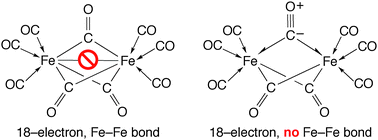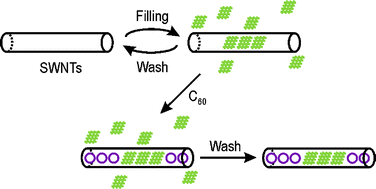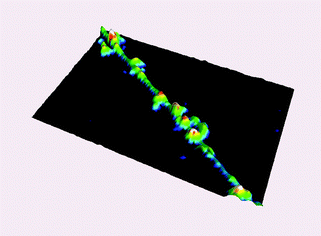Themed collection Malcolm Green FRS: In celebration of his 80th Birthday

The occurrence and representation of three-centre two-electron bonds in covalent inorganic compounds
3-Centre 2-electron (3c–2e) interactions can be classified according to whether the pair of electrons are provided by two atoms (Class I) or by one atom (Class II). Recognizing that compounds with symmetrically bridging carbonyl ligands can belong to Class II provides a simple rationalization of the absence of M–M bonds in molecules such as Fe2(CO)9 and [CpFe(CO)2].

Chem. Commun., 2012,48, 11481-11503
https://doi.org/10.1039/C2CC35304K
A simple method for the containment and purification of filled open-ended single wall carbon nanotubes using C60 molecules
Materials encapsulated inside opened SWNTs can be sealed using fullerenes as “corks”, to block the ends and thereby provide a way to remove the excess of external soluble material present after the filling step.

Chem. Commun., 2008, 2164-2166
https://doi.org/10.1039/B800881G
Directly observed covalent coupling of quantum dots to single-wall carbon nanotubes
Metal

Chem. Commun., 2002, 366-367
https://doi.org/10.1039/B110690B
Evidence for zirconocene dications in Kaminsky type catalysts
Capillarity and silver nanowire formation observed in single walled carbon nanotubes
The opening and filling of single walled carbon nanotubes (SWTs)
Equilibria in the B(C6F5)3–H2O system: synthesis and crystal structures of H2O·B(C6F5)3 and the anions [HOB(C6F5)3]– and [(F5C6)3B(µ-OH)B(C6F5)3]–
Studies of ansa-bis(cyclopentadienyl)tungsten derivatives
New transition-metal derivatives of the fullerene C60
Synthesis of carbon nanotubes containing metal oxides and metals of the d-block and f-block transition metals and related studies
Molybdenum and tungsten carbides as catalysts for the conversion of methane to synthesis gas using stoichiometric feedstocks
Syntheses and reactions of ansa-[2,2-bis(η-cyclopentadienyl)propane]-tungsten and -molybdenum compounds
New ansa-metallocenes of the Group 4 transition metals as homogeneous catalysts for the polymerization of propene and styrene
Transition metal-carbonyl, -hydrido and -η-cyclopentadienyl derivatives of the fullerene C60
Half-sandwich η-cycloheptatri-ene and -enyl derivatives of titanium and zirconium
Reversible dihydrogen addition to a tungsten–tungsten triple bond: X-ray crystal structure of {[W(η-C5H4Pri)Cl2]2}
A new mechanism for exchange processes observed in the compounds [M(η-C5H5)2(exo-η-RCH![[double bond, length half m-dash]](https://www.rsc.org/images/entities/char_e006.gif) CH2)H], M = Nb and Ta
CH2)H], M = Nb and Ta
The enhancement of intercalation reactions by ultrasound
New organometallic solids: synthesis and solid state properties of salts of redoxactive organometallic clusters
Activation of alkanes involving rhenium atoms: synthesis and electronic structure of binuclear µ-alkylidene derivatives; molecular structure of [{Re(η-C6H6)}2(µ-CHBut)(µ-H)2]
Hexakis(trimethylphosphine)molybdenum chemistry: dinitrogen, ethylene, butadiene, η-cyclopentadienyl, and related derivatives
Formation of η-cyclopentadienylpentahydrido(trimethylphosphine)tungsten from cyclopentane, trimethylphosphine, and tungsten atoms
A new route to chiral bis-tertiary phosphine ligands: synthesis, resolution, and crystal structure of trans-bis-1,2-(diphenylphosphino)-cyclopentane and the nickel adduct NiBr2[trans-1,2-(PPh2)2C5H8]
Trimethylphosphine as a reactive solvent: synthesis and crystal structure of Ta(PMe3)3(η2-CH2–PMe2)(η2-CH–PMe2) and synthesis of related molybdenum and tungsten compounds
Evidence for a direct bonding interaction between titanium and a β-C–H moiety in a titanium–ethyl compound; X-ray crystal structure of [Ti(Me2PCH2CH2PMe2)EtCl3]
Synthesis of zerovalent bis(η-arene) compounds of zirconium, hafnium, niobium, tantalum, and tungsten using the metal vapours
Synthesis and reactions of binuclear molybdenocene and tungstenocene derivatives
Infrared spectroscopic evidence for photochemical generation of the metallocenes [(η-C5H5)2M](M = Mo or W) in low-temperature matrices
Activation of sp2 and sp3 carbon–hydrogen bonds via thermolysis of bis(η-cyclopentadienyl)hydridomethyltungsten
Evidence for a reversible 1,2-hydrogen shift (α elimination) in some bis(η-cyclopentadienyl)tungsten compounds
Mechanism for the stereospecific polymerization of olefins by Ziegler–Natta catalysts
Organometallic intercalation of metal dichalcogenides: intercalates of zirconium disulphide and low ionisation potential sandwich compounds
Photo-induced insertion of tungsten into a methyl C–H bond in p-xylene and mesitylene: crystal structure of (η-C5H5)2W[CH2(3,5-Me2C6H3)]2
Synthesis of bis-π-benzene-titanium and -molybdenum using metal vapours
A bonding model for bent bis-(π-cyclopentadienyl) metal compounds
Arene molybdenum chemistry: some π-allyl, hydrido, and dinitrogen derivatives
Formation of a tangsten phenyl hydride derivatives from benzene
955. The di-π-cyclopentadienyl hydrides of tantalum, molybdenum, and tungsten
Proceedings of the Chemical Society. October 1961
795. Biscyclopentadienylrhenium hydride
About this collection
Malcolm was born in Eastleigh, Hampshire, on the 16th of April, 1936. He received his B. Sc. (Hons) in 1956 from the University of London (Acton Technical College) and his Ph. D. in 1959 from Imperial College of Science and Technology, where he studied under Professor Sir Geoffrey Wilkinson. Following Imperial College, Malcolm moved to Cambridge University in 1960, and finally to Oxford University in 1963, where he was appointed University Lecturer and Septcentenary Fellow in Inorganic Chemistry at Balliol College. On the 2nd of January 1965, he married Jennifer Green (née Bilham), with whom he has also enjoyed a long time scientific collaboration. Malcolm became a Fellow of the Royal Society in 1985 and was appointed Statutory Professor and Head of the Inorganic Chemistry Laboratory and Professorial Fellow of St. Catherine's College in 1989. He became a research active Emeritus Professor in 2003 and continues to publish to this day.
Malcolm’s contributions to inorganic chemistry are numerous and varied. His first publication, which bears the title “Bis cyclopentadienylrhenium hydride”, appeared in 1958 and was based on his Ph. D. thesis which was entitled “A study of some transition metal hydrides and olefin complexes.” To date, he has published more than 600 papers describing synthetic, structural, and mechanistic aspects of the chemistry of virtually every transition element. In order to give the reader a flavour of the research that Malcolm has performed, the present collection provides a selection of his papers that have been published in journals of the Royal Society of Chemistry over a period of more than fifty years. For example, these papers show how Malcolm’s research popularized the now ubiquitous molybdenocene and tungstenocene systems which provided evidence for alpha and beta hydrogen migratory insertion reactions, and also early examples of C–H bond activation. Read the full commentary here.